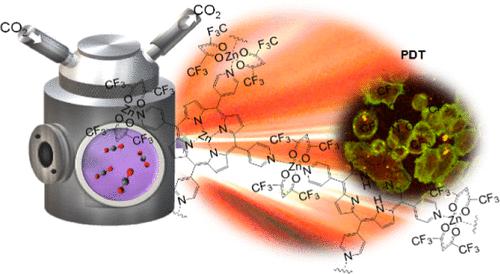当前位置:
X-MOL 学术
›
Chem. Mater.
›
论文详情
Our official English website, www.x-mol.net, welcomes your feedback! (Note: you will need to create a separate account there.)
Supercritical CO2 Synthesis of Porous Metalloporphyrin Frameworks: Application in Photodynamic Therapy
Chemistry of Materials ( IF 8.6 ) Pub Date : 2023-01-30 , DOI: 10.1021/acs.chemmater.2c03018 Márta Kubovics 1 , Oriol Careta 2 , Oriol Vallcorba 3 , Guillermo Romo-Islas 4, 5 , Laura Rodríguez 4, 5 , Jose A Ayllón 6 , Concepción Domingo 1 , Carme Nogués 2 , Ana M López-Periago 1
Chemistry of Materials ( IF 8.6 ) Pub Date : 2023-01-30 , DOI: 10.1021/acs.chemmater.2c03018 Márta Kubovics 1 , Oriol Careta 2 , Oriol Vallcorba 3 , Guillermo Romo-Islas 4, 5 , Laura Rodríguez 4, 5 , Jose A Ayllón 6 , Concepción Domingo 1 , Carme Nogués 2 , Ana M López-Periago 1
Affiliation

|
A series of porous metalloporphyrin frameworks prepared from the 5,10,15,20-tetra(4-pyridyl)porphyrin (H2TPyP) linker and four metal complexes, M(hfac)2 M = Cu(II), Zn(II), Co(II), and Ni(II) (hfac: 1,1,1,5,5,5-hexafluoroacetylacetonate), were obtained using supercritical CO2 (scCO2) as a solvent. All the materials, named generically as [M-TPyP]n, formed porous metal–organic frameworks (MOFs), with surface areas of ∼450 m2 g–1. All MOFs were formed through the coordination of the metal to the exocyclic pyridine moieties in the porphyrin linker. For Cu(II), Zn(II), and Co(II), incomplete metal coordination of the inner pyrrole ring throughout the structure was observed, giving place to MOFs with substitutional defects and leading to a certain level of disorder and limited crystallinity. These samples, prepared using scCO2, were precipitated as nano- to micrometric powders. Separately, a layering technique from a mixture of organic solvents was used to crystallize high-quality crystals of the Co(II) based MOF, obtained with the formula [{Co(hfac)2}2H2TPyP]n. The crystal structure of this MOF was elucidated by single-crystal synchrotron X-ray diffraction. The Zn(II)-based MOF was selected as a potential photodynamic therapy drug in the SKBR-3 tumoral cell line showing outstanding performance. This MOF resulted to be nontoxic, but after 15 min of irradiation at 630 nm, using either 1 or 5 μM concentration of the product, almost 70% of tumor cells died after 72 h.
中文翻译:

多孔金属卟啉骨架的超临界 CO2 合成:在光动力疗法中的应用
由 5,10,15,20-四(4-吡啶基)卟啉 (H 2 TPyP) 连接体和四种金属络合物 M(hfac) 2 M = Cu(II), Zn(II)制备的一系列多孔金属卟啉框架)、Co(II) 和 Ni(II)(hfac:1,1,1,5,5,5-六氟乙酰丙酮)是使用超临界 CO 2 (scCO 2 ) 作为溶剂获得的。所有材料,统称为 [M-TPyP] n,形成多孔金属有机骨架 (MOF),表面积为 ∼450 m 2 g –1. 所有 MOF 都是通过金属与卟啉接头中的环外吡啶部分配位形成的。对于 Cu(II)、Zn(II) 和 Co(II),观察到整个结构中吡咯内环的不完全金属配位,取代了具有替代缺陷的 MOF,导致一定程度的无序和有限的结晶度。这些使用 scCO 2制备的样品被沉淀为纳米级到微米级的粉末。另外,使用有机溶剂混合物的分层技术来结晶基于 Co(II) 的 MOF 的高质量晶体,该晶体的分子式为 [{Co(hfac) 2 } 2 H 2 TPyP ] n. 这种 MOF 的晶体结构是通过单晶同步加速器 X 射线衍射阐明的。Zn(II) 基 MOF 被选为 SKBR-3 肿瘤细胞系中的潜在光动力治疗药物,表现出优异的性能。该 MOF 无毒,但在 630 nm 照射 15 分钟后,使用 1 或 5 μM 浓度的产品,72 小时后几乎 70% 的肿瘤细胞死亡。
更新日期:2023-01-30
中文翻译:

多孔金属卟啉骨架的超临界 CO2 合成:在光动力疗法中的应用
由 5,10,15,20-四(4-吡啶基)卟啉 (H 2 TPyP) 连接体和四种金属络合物 M(hfac) 2 M = Cu(II), Zn(II)制备的一系列多孔金属卟啉框架)、Co(II) 和 Ni(II)(hfac:1,1,1,5,5,5-六氟乙酰丙酮)是使用超临界 CO 2 (scCO 2 ) 作为溶剂获得的。所有材料,统称为 [M-TPyP] n,形成多孔金属有机骨架 (MOF),表面积为 ∼450 m 2 g –1. 所有 MOF 都是通过金属与卟啉接头中的环外吡啶部分配位形成的。对于 Cu(II)、Zn(II) 和 Co(II),观察到整个结构中吡咯内环的不完全金属配位,取代了具有替代缺陷的 MOF,导致一定程度的无序和有限的结晶度。这些使用 scCO 2制备的样品被沉淀为纳米级到微米级的粉末。另外,使用有机溶剂混合物的分层技术来结晶基于 Co(II) 的 MOF 的高质量晶体,该晶体的分子式为 [{Co(hfac) 2 } 2 H 2 TPyP ] n. 这种 MOF 的晶体结构是通过单晶同步加速器 X 射线衍射阐明的。Zn(II) 基 MOF 被选为 SKBR-3 肿瘤细胞系中的潜在光动力治疗药物,表现出优异的性能。该 MOF 无毒,但在 630 nm 照射 15 分钟后,使用 1 或 5 μM 浓度的产品,72 小时后几乎 70% 的肿瘤细胞死亡。



























 京公网安备 11010802027423号
京公网安备 11010802027423号